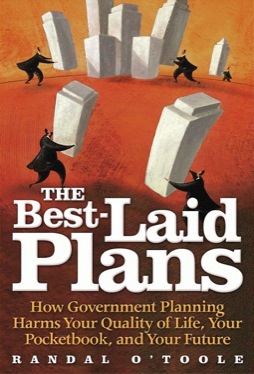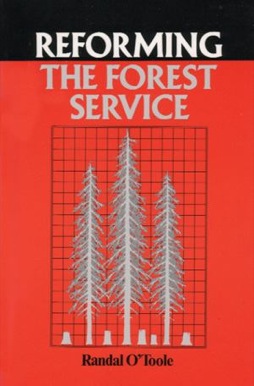Last year was quite possibly the most politically tumultuous since at least 1884, when one presidential candidate was widely believed to have accepted bribes and the other was accused of rape. It seems predictable that, between DOGE, tariffs, immigration disputes, and international strife, 2025 will be even more politically fractious. Whether that’s a good thing may depend on your political persuasion.
Grizzly steps gingerly into the New Year.
Last year ended with the death of Jimmy Carter, who has often been described as a failed president but a great ex-president. Yet for the last few days we’ve been treated to a debate about just how bad a president he was and whether his post-presidency was all that was claimed.
I can add only a single anecdote to this debate. During Carter’s presidency, the nation was being racked by inflation as high as 9 percent per year. To fight this inflation, at the suggestion of economist Alfred Kahn, Carter ordered the Forest Service to step up its timber sale program beyond sustainable levels. This must have been early in 1978.
This was a shock to environmentalists, especially considering that Carter’s efforts to save Alaska wilderness had given him a reputation as the most environmentally oriented president since Theodore Roosevelt. His willingness to sacrifice the national forests to slightly reduce timber prices seemed crass.
As it happened, I had recently written a paper about the national forests that caught the attention of Forest Service Chief John McGuire, who asked me to meet with him about having Forest Service researchers study my ideas in more detail. Although I would soon be known as one of the Forest Service’s leading critics, getting an invitation to meet with the agency’s chief was quite an honor.
The meeting went well, and at the end I happened to ask Chief McGuire what the Forest Service was going to do about Carter’s order to increase timber sales. “The president ordered us to study the possibility of increasing timber sales,” he said with a smirk. “We’ll study it!”
That answer thrilled me at the time as it showed that, on this subject at least, the Forest Service was on the environmental side. While I had previously had indications that this was true, it was a relief to have it affirmed.
In the long run, however, I realized that McGuire had given me my first glimpse at the so-called Deep State in action. An entrenched bureaucracy was willfully ignoring the direction given to it by the elected president. As an outgrowth of the Progressive Era, the Forest Service was the model of an agency run by experts who thought it was their mission to work for the benefit of the people. What should happen when the agency’s policies conflict with the policies of a president who also thought he was working for the benefit of the people?
Certainly the agency had more expertise about on-the-ground forestry than the president could have. But was it really working for the public benefit? My later research showed that many Forest Service policies were aimed at increasing its own budget. For example, by limiting timber sales to an amount that could be sustained in the long run, the Forest Service was effectively holding timber hostage to Congress’ willingness to fund forest management programs that would make trees grow faster and increase the long-run sustained-yield capacity of the forests. If the Forest Service allowed itself to cut more than could be sustained, Congress would have no incentive to fund those programs.
(This was, in fact, the subject of the meeting I had with McGuire. If the Forest Service could use such practices as thinnings and genetic improvement of trees to justify increase cutting of old growth today, I had written, then it could use those practices instead of cutting timber in the roadless areas that my clients wanted to save as wilderness. The Forest Service study that McGuire ordered found that this would work on some national forests but not on others — which also meant that, under its sustained-yield policy, its claim that increased funding would allow increased cutting worked on some national forests but not on others.)
Carter’s order wasn’t really in the public interest either. While the agency’s sustained-yield policies were debatable, increasing subsidies to one good in order to lower its market price does nothing to stop the forces that cause inflation, which are about much more than a single price. In fact, he probably could have done more to eliminate inflation by reducing federal deficit spending on such things as money-losing national forest timber sales.
This coming year is going to see this debate played out repeatedly as the Department of Government Efficiency tries to cut spending on programs run by bureaucrats who consider themselves experts working in the public interest. Just about everyone thinks they could do a better job if they had a bigger budget, so it will be hard for the incoming administration to convince people that cutting the budgets of various federal agencies will lead to greater benefits than costs.
As I previously noted, my own solution to this conundrum is for DOGE to focus on changing the incentives faced by bureaucrats so that they themselves will find ways to streamline their operations and improve the work they do for the public. We will soon see whether Musk and Ramaswamy attempt to do something like this.









solution to this conundrum…
– salary freeze
– layoff half the depts staff
By 2021 Twitter had 7,500 employees,
now below 2,300.
Streamlining a organization. required significant cost-cutting measures. Musk has said that Twitter had many employees but little product development, and that if you don’t care about censorship, you don’t need a lot of people running Twitter.
year ago, FBI announced new Central Headquarters in Prince georges county Maryland, having obtained 61 acres in Greenbelt, MD. WHY?
FBI has numerous satellite offices across the US, in 2017, they opened one in Boston-area.
https://www.gsa.gov/about-us/gsa-regions/region-1-new-england/region-1-newsroom/press-releases/gsa-and-fbi-open-new-boston-field-office-03102017
A quick search on LOOPNET, shows DC and DC area have for just 10 buildings alone 1.2 Million square feet of office space and DC has 2.5 million available.
With the new year, it might be a good time to clear out some dead sites from the Faithful Allies sidebar:
– http://americandreamcoalition.org/
– http://www.californiachaparral.com/
janehavisham,
Good idea. Thanks.
DOGE should start out by recommending the elimination of baseline budgeting. Every agency will have to justify every dollar allocated to them.
Also, zero out all government funded activism. No more paying fake charities to lobby for more funding.
That’s one tool in a manager’s toolbox. Others are shuffling recalcitrant managers off to positions where they have little power or offering them attractive buy-out packages. Both Musk and Ramaswamy have plenty of experience turning organizations around. The fact that the federal government is the largest employer in the United States gives them a challenge but of course their boss is no stranger to rapid organizational change either. I think it’s going to be fun for all three gentlemen. I also think that the majority of the employees in those organizations will get on board after experiencing decades of corruption and bureaucratic bloat in their respective organizations. Many of those employees’ skills are still needed and they’ll look forward to being able to utilize those skills again instead of mostly having to kiss ass to get ahead.